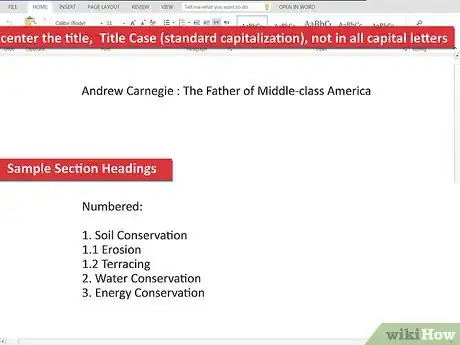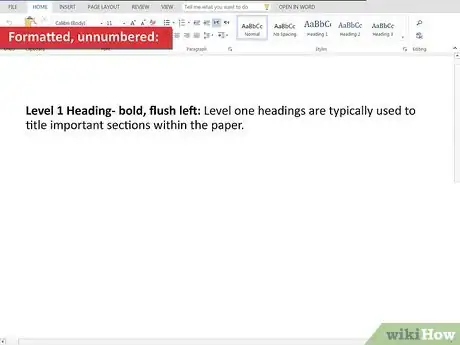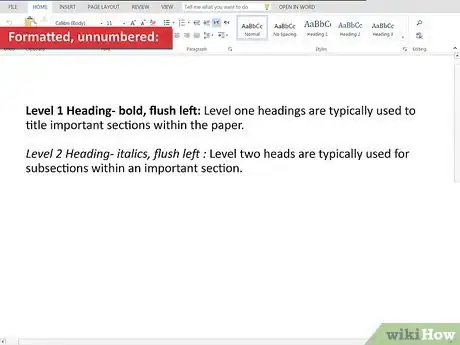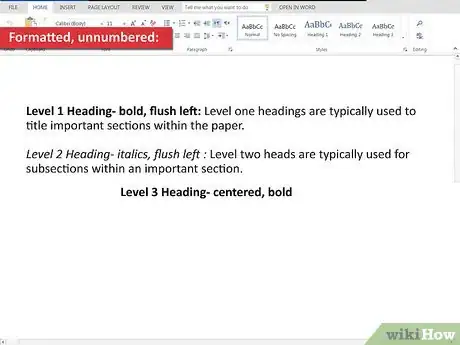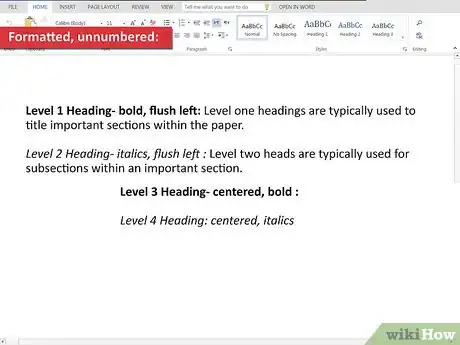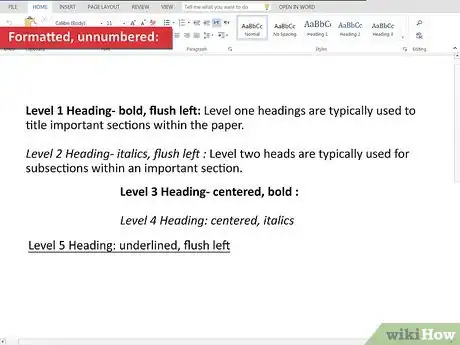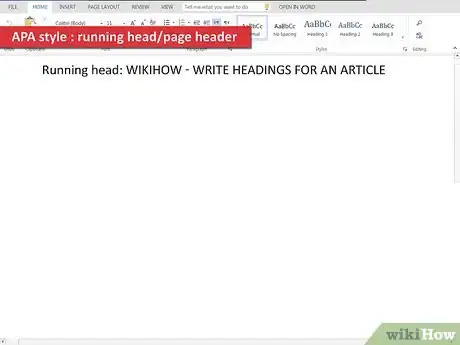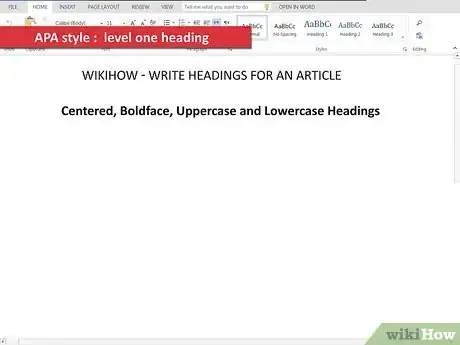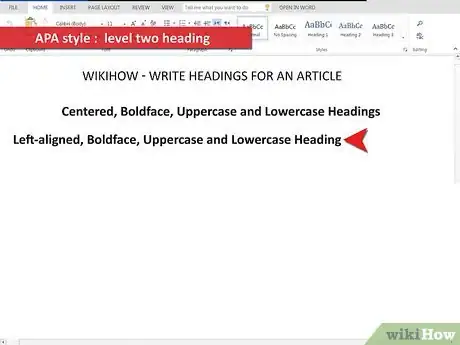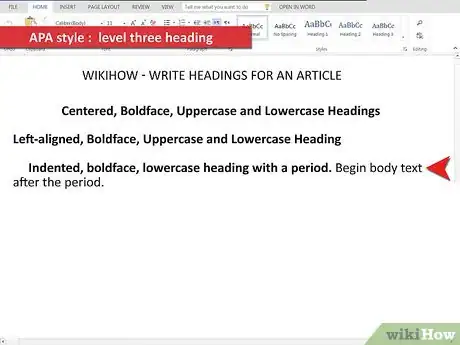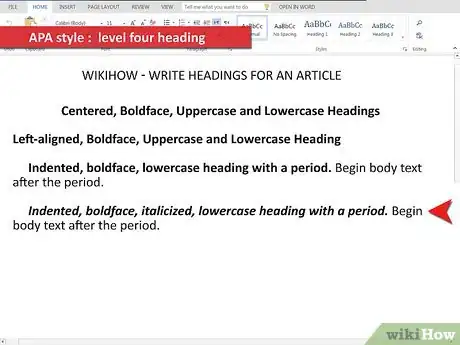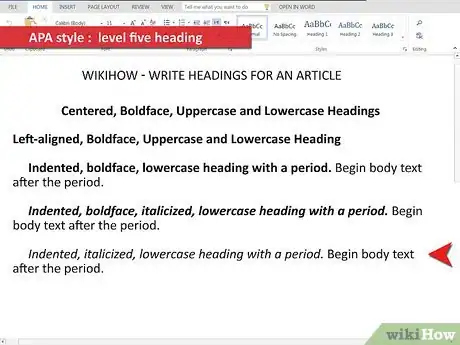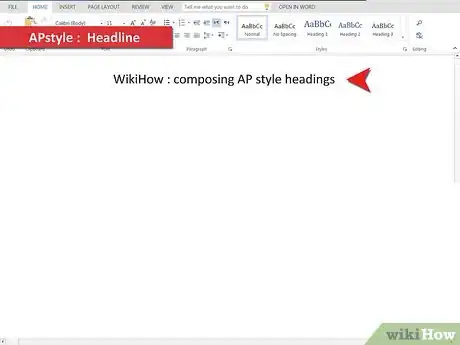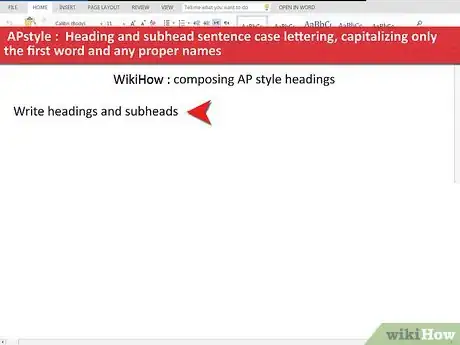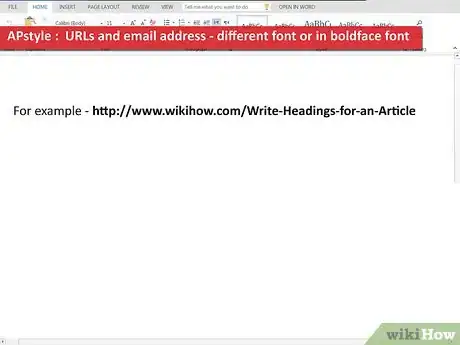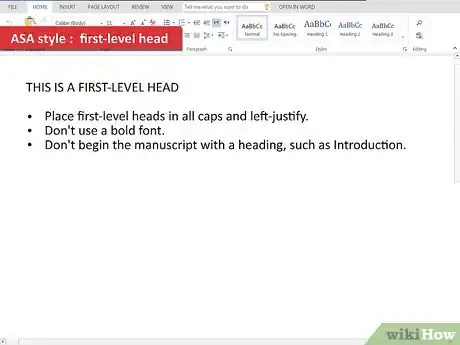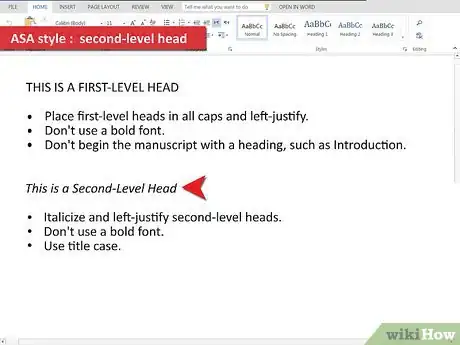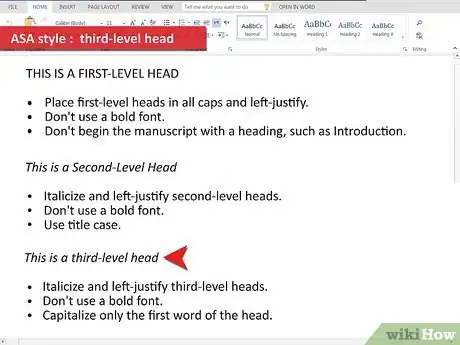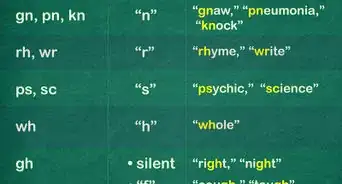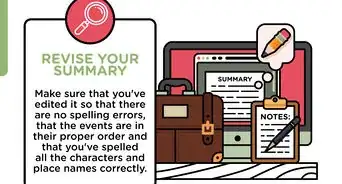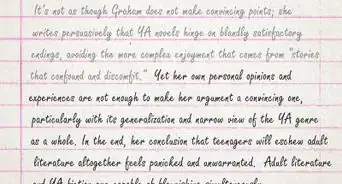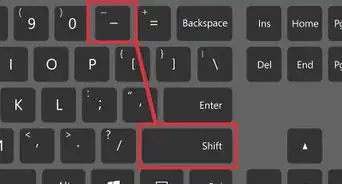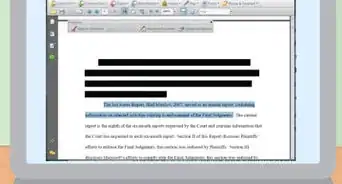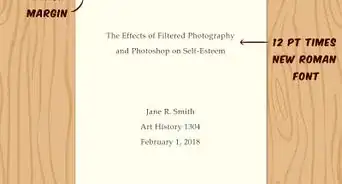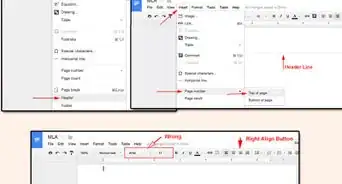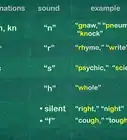This article was co-authored by Megan Morgan, PhD. Megan Morgan is a Graduate Program Academic Advisor in the School of Public & International Affairs at the University of Georgia. She earned her PhD in English from the University of Georgia in 2015.
There are 9 references cited in this article, which can be found at the bottom of the page.
This article has been viewed 58,701 times.
Headings are important, as they help organize the contents of an article, and they allow a reader to skim the article to single out important or relevant sections of the article.[1] Headings must be relevant and concise. How you format a given heading will vary considerably, depending on the style you use to write your article. Common formatting styles for articles include Modern Language Association (MLA) style, American Psychological Association (APA) style, Associated Press (AP) style, and American Sociological Association (ASA) style. Knowing how to write useful headings in your chosen formatting style can help you write a better, more organized article.
Steps
Writing MLA Style Headings
-
1Create a section heading. Modern Language Association (MLA) style is typically used for articles and papers within the liberal arts and humanities.[2] Section headings are frequently used to help organize the parts of a larger article or paper.
- MLA style essays with multiple sections should have numbered headings. Use an arabic number and period, then a space, followed by the section title. Capitalize the first letter of important words and use lowercase for the rest.[3]
-
2Write a level one heading. Level one headings are typically used to title important sections within the paper.
- Level one headings are written in boldface font, flush left with the margin.[4]
Advertisement -
3Compose a level two heading. Level two heads are typically used for subsections within an important section.
- Level two headings are written in italics, without any bold font. The text should be flush left with the margin.[5]
-
4Write a level three heading. Level three headings are frequently used for substantial subsections within an existing subsection.
- Level three headings are written in bold, without italics. The text should be centered within the body of the paper.[6]
-
5Create a level four heading. Level four headings are used for substantial subsections within an already divided section. In other words, use a level four heading to title a subsection below a level three heading, within the level three heading's subsection.
- Level four headings are written in italics, without any bold font. The text should be centered within the body of the paper.[7]
-
6Write a level five heading. Level five headings are used to title a subsection within a highly-divided section.
- Level five headings are written with underlined text, and without any bold or italicized font. The text should be flush left with the margin.[8]
Writing Headings for APA Articles
-
1
-
2Compose a level one heading. Level one headings give the title of one section in an article. Level one headings may be the only heading in an article, if the article only contains one long section.[13]
- Level one headings should be centered in the middle of the page and typed in boldface font. The heading should use a mix of uppercase and lowercase letters, as appropriate.[14]
- Generally, only major words are capitalized in APA format. In cases of a hyphenated compound word, only the first word is capitalized.[15]
- Level one headings do not use any end punctuation, and should be followed by a line break.[16]
-
3Create a level two heading. Level two headings give the title of a subsection within one section of an article.[17]
- Level two headings should be left-aligned (flush with the left margin), typed in boldface font.[18]
- Level two headings should use a mix of uppercase and lowercase letters, as appropriate. This follows the same general rule as a level one heading.[19]
- Level two headings do not use any end punctuation, and should be followed by a line break.[20]
-
4Write a level three heading. Level three headings give the title of a subsection within a subsection in an article.[21]
- Level three headings should be indented from the left margin, typed in boldface font.[22]
- Level three headings should be written in sentence case, where only the first letter of the heading is capitalized and the rest of the text is in lower case. The heading should end with a period and a space, and be followed immediately by the text of that subsection.[23]
-
5Create a level four heading. Level four headings follow the same guidelines as level three headings, except that level four headings are typed in boldface and italicized font.[24]
- Level four headings should be indented from the left margin, typed in boldface, italicized font with sentence case lettering. End a level four heading with a period, and begin the text immediately after the space that follows that period.[25]
-
6Write a level five heading. Level five headings follow the same guidelines as level four headings, except they are written in italicized font without any boldface.[26]
- Level five headings should be indented from the left margin, typed in italicized font without any boldface. Use sentence case lettering, end the heading with a period, and begin the text immediately after the space that follows that period.[27]
Composing AP Style Headings
-
1Write a headline. Associated Press (AP) style is primarily used for news writings across major newspapers, magazines, and public relations firms.[28] Since AP style is typically used for news articles, most AP style articles require a headline.
-
2Write headings and subheads. In AP style, headings and subheads follow the same guidelines as AP style headlines.
- Use sentence case lettering, capitalizing only the first word and any proper names.
-
3Use a consistent font. AP style typically avoids using italicized or boldface fonts, with the occasional exception of URLs or email addresses within the article.
- URLs and email addresses may be written in a different font or in boldface font to differentiate website periods from sentence-ending periods.
Creating Headings for ASA Articles
-
1Write a first-level head. American Sociological Association (ASA) style is typically used for sociological articles and papers. In ASA style, the first-level head is used to title a major section within the article.[31]
-
2
-
3Compose a third-level head. Third-level heads are used to title a subsection within a subsection in a larger article.[36]
- Third-level heads should be left-justified and italicized. Use sentence case lettering, where only the first word of the heading is capitalized and the rest is in lowercase lettering.[37]
Warnings
- Don't attempt to write your title/heading without writing your article. This will be exceedingly difficult, as the heading(s) should serve as a guide to the information in that section.⧼thumbs_response⧽
References
- ↑ https://writing.wisc.edu/handbook/documentation/docapa/docapaheadings/
- ↑ https://owl.english.purdue.edu/owl/resource/747/01/
- ↑ https://owl.english.purdue.edu/owl/resource/747/01/
- ↑ https://owl.english.purdue.edu/owl/resource/747/01/
- ↑ https://owl.english.purdue.edu/owl/resource/747/01/
- ↑ https://owl.english.purdue.edu/owl/resource/747/01/
- ↑ https://owl.english.purdue.edu/owl/resource/747/01/
- ↑ https://owl.english.purdue.edu/owl/resource/747/01/
- ↑ https://owl.english.purdue.edu/owl/resource/560/05/
- ↑ https://owl.english.purdue.edu/owl/resource/560/01/
- ↑ https://owl.english.purdue.edu/owl/resource/560/01/
- ↑ https://owl.english.purdue.edu/owl/resource/560/01/
- ↑ https://writing.wisc.edu/handbook/documentation/docapa/docapaheadings/
- ↑ https://writing.wisc.edu/handbook/documentation/docapa/docapaheadings/
- ↑ https://owl.english.purdue.edu/owl/resource/560/05/
- ↑ https://writing.wisc.edu/handbook/documentation/docapa/docapaheadings/
- ↑ https://writing.wisc.edu/handbook/documentation/docapa/docapaheadings/
- ↑ https://owl.english.purdue.edu/owl/resource/560/16/
- ↑ https://owl.english.purdue.edu/owl/resource/560/16/
- ↑ https://writing.wisc.edu/handbook/documentation/docapa/docapaheadings/
- ↑ https://writing.wisc.edu/handbook/documentation/docapa/docapaheadings/
- ↑ https://owl.english.purdue.edu/owl/resource/560/16/
- ↑ https://writing.wisc.edu/handbook/documentation/docapa/docapaheadings/
- ↑ https://owl.english.purdue.edu/owl/resource/560/16/
- ↑ https://owl.english.purdue.edu/owl/resource/560/16/
- ↑ https://owl.english.purdue.edu/owl/resource/560/16/
- ↑ https://owl.english.purdue.edu/owl/resource/560/16/
- ↑ https://owl.english.purdue.edu/owl/resource/735/02/
- ↑ https://www.apstylebook.com/?do=ask_editor&pg=faq
- ↑ https://www.apstylebook.com/?do=ask_editor&pg=faq
- ↑ https://owl.english.purdue.edu/owl/resource/583/01/
- ↑ https://owl.english.purdue.edu/owl/resource/583/01/
- ↑ https://owl.english.purdue.edu/owl/resource/583/01/
- ↑ https://owl.english.purdue.edu/owl/resource/583/01/
- ↑ https://owl.english.purdue.edu/owl/resource/583/01/
- ↑ https://owl.english.purdue.edu/owl/resource/583/01/
- ↑ https://owl.english.purdue.edu/owl/resource/583/01/
- ↑ https://owl.english.purdue.edu/owl/resource/717/02/
